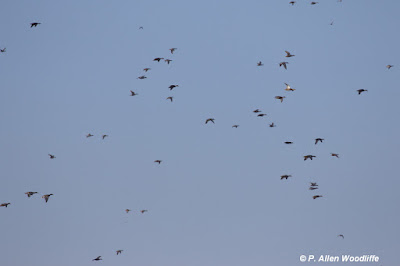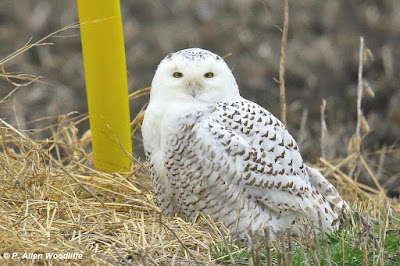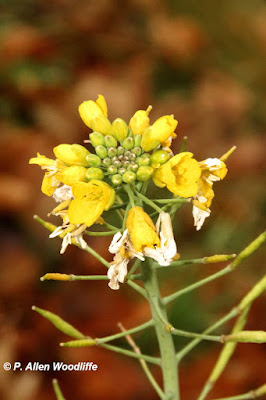The Christmas Bird Count season is now over, except for finalizing numbers and entering them on the Audubon web site that hosts all the data from the thousands of counts held each year.
On Jan 1, we had the St. Clair National Wildlife Area CBC. I have been the compiler for this count since 1988. The weather was quite mild, about 5C, with light north winds. There was no ice or snow anywhere, which had advantages such as having lots of open habitat for the thousands of waterfowl and other waterbirds to occupy. Driving around was not a problem either, and spotting the white Snowy Owls against a dark farmland background made achieving a record number of that species much more likely. The disadvantage of such mild, open conditions, is that so much wetland habitat was unobservable due to the numerous open spots not visible to where we were able to access. So there were probably some species, and overall numbers, that were not documented.
How did all of this play out? We had 15 observers spread over the count circle, and saw 91 species, a bit shy of our record of 93 species seen a few years ago, but quite respectable. Waterfowl were well represented by 25 species, but by far the most abundant were ducks such as Mallards, shown in flight with a few American Black Ducks. At times it seemed much of the sky was filled with flocks of various sizes and mixes. We recorded over 10000 Mallards, but due to the inaccessibility of some prime wetland areas, there were likely more. (Note: most, but not all of the following photos were taken on the day of the count. When one is walking several kilometres carrying a 'scope and tripod, one sometimes decides not to carry those few extra pounds of camera equipment, especially with the threat of rain. However they represent what was actually seen on the day, even though they were taken a few days before, or a few days after, the count day.)
Northern Shovelers were present in good numbers, at least for that species, with 132 individuals recorded.
Canada Geese were numerous as well, with almost 9000 recorded. Some flocks were resting and feeding in fields of green....
...while others were scattered in the lower, wetter areas of harvested farm fields.
About half as many Tundra Swans as Canada Geese were recorded, in flight to or from their feeding and resting areas....
....but most easily in the open wetlands of the NWA.
A small number of Sandhill Cranes was observed, well away from the road, and almost invisible as their plumage blends well with the harvest corn field. The 25 cranes seen on the day beat the previous count record of 10.
We added two new species to the overall count list, with one each of Orange-crowned Warbler and Sora documented by two separate groups of birders. Somewhat surprisingly we missed species such as Hairy Woodpecker, Redhead both of which were undoubtedly present somewhere.
We did get a new record for Snowy Owls, as anticipated, but never for certain until all the results are in. The previous high was 18 birds, and this year we collectively recorded 23! The actual total reported was even higher, but after taking into consideration the probability of double-counting, settled on 23. When this count started back in 1981, we considered ourselves fortunate to record even one or two. Some years we didn't find any. In the decade prior to this day, however, we have never missed them, and have averaged 7 birds over that decade. Adding these 23 to the 2022 results will definitely boost the average a bit higher. One group of birders more or less in the heart of the snowies wintering territory was able to do a careful count and saw 11 from one vantage point!
Most were well out in the fields, but several were close enough for some quite satisfying photographs, as the following results will show. While not all of the photos shown above were taken on the day of the count, these snowy photos were.
To further illustrate how mild the weather had been to this point, I noticed this plant still in flower, with some individual flowers still in development! It is a member of the Mustard family.
What a difference a day makes.
The day after the SCNWA CBC was the Skunk's Misery CBC, centered just west of Bothwell in eastern Chatham-Kent. As mentioned previously, as yesterday went along, the weather deteriorated, first with some light rain, then by the end of the day, some of it had transitioned to a wintry mix. Overnight, it had changed fully to snow, and by daybreak there was 8-15 cm on the ground, depending on where you were. While that wasn't too bad for a winter's day, it made traveling a little treacherous in places. Nonetheless, birders went out and began covering the designated territories as soon as they could.
My territory was not nearly as productive as that of the previous day at SCNWA, but then it never is since the habitat is vastly different. The snow and cold did not help. The overall count currently stands at 64 species, although there is always the possibility of late additions.
I was mostly on my own, but did team up with Brett & Vicki for a few hours as we traversed a woodland that we had access to at the northern edge of Skunk's Misery. It was definitely worthwhile with some nice additions to our day's list, and two Golden Eagles were highlights. But since that was along a section of the 5 km trek which required that we go through the sometimes wet woods, none of us had a camera. Afterwards I jokingly said that the one was so close we might have gotten an acceptable record shot with a cell phone camera had we thought of that at the time.
Much of the territory was on private land with limited access, so combing through the countryside via the local road system is part of the process. I took a few photos of some birds along the way, such as these Mourning Doves.....
....with quite a surprising photo op of an adult Bald Eagle feeding on the remains of a carcass of some mammal just a few metres from the roadside. Fortunately it was not feeling any threat from me stopped along the road with my camera pointed out the window. These are hardly cropped at all.
A day or so later, I had the opportunity to look for Long-eared Owl and Northern Saw-whet Owl, both of which had been recorded on the Blenheim/Rondeau bird count. While I had a brief look at a Long-ear, I was not able to get any photos of it. I had more success with the saw-whet although it was well hidden near the top of a cedar tree. This first image is most of what I initially saw, at an equivalent of about 8X.
From a slightly different angle and cropping a bit, it got better........and finally when I pished slightly, I got its attention just enough for it to take a quick look at me, giving me the eye as I had likely disturbed its daytime rest.
It seems that this little owl species is most often well, or at least partially, hidden. On occasion they will sit right out in the open, such as the time I photographed this one at eye level in a small white pine tree after a recent heavy snow fall.
This was back in the early 1980s, so obviously this isn't an original image, but a photo of my photo. I was fortunate enough to have it selected for the December, 1988 calendar produced by Nature Canada.If you wish to subscribe, or unsubscribe, to Nature Nuggets, send an email to prairietramper@gmail.com























No comments:
Post a Comment